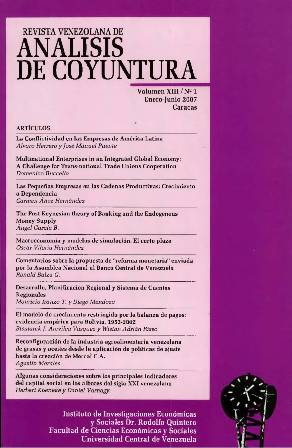THE POST KEYNESIAN THEORY OF BANKING AND THE ENDOGENOUS MONEY SUPPLY
DOI:
https://doi.org/10.54642/rvac.v13i1.10471Palabras clave:
Endogenous money supply, horizontalist, structuralist, generic and specific risksResumen
This paper seeks to contribute by presenting an assessment of the relevant literature on banking and the endogenous money supply. The focus is placed on the Post Keynesian perspective, though traditional approaches are briefly discussed as well. The paper argues that, due to scope economies, banks are mistakenly confused with financial intermediaries; a common finding in the traditional literature. This is not the case of both the Post Keynesian view and the Circuit approach. Those perspectives, on the contrary, by reversing the causal link implied by the quantity theory of money, the base-multiplier and the saving-investment cycle as well as by focusing on a flow-perspective of money and on the asset side of banks’ balance sheets, are both able to explain the core of the banking business and, hence, the very nature of the endogenous money supply. The paper shares the view of Screpanti (1997) for whom "...Banks make the generic credit risk saleable". They transform risky, illiquid, nonmarketable assets based on personal credit into safe, liquid, and marketable bank deposits which are socially perceived as money. The paper considers as well the major divergence among the Post Keynesian Horizontalist approach and the Post Keynesian Structuralist or Partial Accommodation approach; namely the exogeneity of the interest rate. Here, as in Screpanti (1997) and Wray (2004), such a divergence is assessed rather as the result of an imprecision in the definition of time horizons, or as a misinterpretation of the impact of cyclically increasing risk upon the determination of markups and bank rates.Descargas
Descargas
Cómo citar
García B., A. (2016). THE POST KEYNESIAN THEORY OF BANKING AND THE ENDOGENOUS MONEY SUPPLY. Revista Venezolana De Análisis De Coyuntura, 13(1). https://doi.org/10.54642/rvac.v13i1.10471
Número
Sección
Artículos
Licencia
Los autores que publican en la Revista Venezolana de Análisis de Coyuntura, RVAC, Revista Digital del Instituto de Investigaciones Económicas y Sociales “Dr. Rodolfo Quintero”, de la Universidad Central de Venezuela, están de acuerdo con los siguientes términos:
- Los autores conservan los derechos de autor y garantizan a la revista el derecho de ser la primera publicación del trabajo al igual que licenciado bajo una Creative Commons Attribution License que permite a otros compartir el trabajo con un reconocimiento de la autoría del trabajo y la publicación inicial en esta revista.
- Los autores pueden establecer por separado acuerdos adicionales para la distribución no exclusiva de la versión de la obra publicada en la revista (por ejemplo, situarlo en un repositorio institucional o publicarlo en un libro), con un reconocimiento de su publicación inicial en esta revista y no se use para fines comerciales.
- Los contenidos e imágenes que se incluyen en los artículos son responsabilidad del autor (es). La RVAC, del del Instituto de Investigaciones Económicas y Sociales “Dr. Rodolfo Quintero”, de la Universidad Central de Venezuela, no se hace responsable de la información incluida en ellos.
- Los autores están de acuerdo con la licencia de uso utilizada por la revista, con las condiciones de auto-archivo y con la política de acceso abierto.
- Se permite a los autores difundir electrónicamente (por ejemplo, en repositorios institucionales o en su propio sitio web) la versión publicada de sus obras, ya que favorece su circulación y difusión más temprana y con ello un posible aumento en su citación y alcance entre la comunidad académica.
- En caso de reutilización de las obras publicadas debe mencionarse la existencia y especificaciones de la licencia de uso además de mencionar la autoría y fuente original de su publicación.









